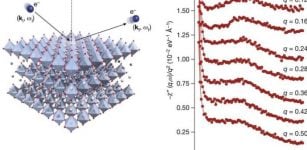Rubber That Can Count To Ten – Physicists’ Successful Experiment With Metamaterial
Eddie Gonzales Jr. – MessageToEagle.com – A block of rubber that can count to ten and even remember the order in which it is pressed—physicists Martin van Hecke and Lennard Kwakernaak (Leiden University and AMOLF Amsterdam) have published about this latest metamaterial in the journal Physical Review Letters.
Lennard Kwakernaak. Credit: Leiden University
“I like finding complexity in simple things.” With a big smile Ph.D. candidate Kwakernaak enters the room, the showpiece in his hands: a piece of soft rubber with 22 beams in pairs. “This is our beam counter. Push it,” he says.
The result is unexpected. The bars all bend to the left except the first one, which bends to the right. “That first bar then pushes the next pair to the right and that moves along one position each time you push the material. That’s how the material counts to ten.”
Material with memory
The rubber block is an example of a mechanical metamaterial: a material whose properties are determined not only by its composition but also by its structure. Van Hecke’s group investigates how simple materials can be used to process information, a bit like a computer.
“When developing such a material, you try to discover the rules of the game,” the Ph.D. candidate explains. “What are you allowed to do? The rule in this case is about the contact of a bar with its direct neighbors.”
The researchers also went one step further than counting, he explains. “Along the way, I found out that you can cause different reactions in the rubber by pushing with different levels of force. By experimenting with this, I was able to make a metamaterial that only counts to the end if you push on it in the right order, with the right amount of force. A kind of lock, in other words.”
Simple solutions to all kinds of problems
One possible use is counting cars from different weight classes driving over a bridge. Or a pedometer, for example, because you can make the metamaterial as big or small as you want. “The big advantage is that such mechanical metamaterials are cheap, robust and low-maintenance,” Kwakernaak says.
Counting metamaterial. Credit: AMOLF
“That makes them interesting for all kinds of applications. It’s hard to say exactly what those will be, but we always find a purpose for new materials like this. For example, earlier research into a material that folds like origami inspired the folding of solar panels on a satellite.”
Kwakernaak himself especially enjoys seeing how seemingly simple things can be very complex. “How such a thin beam bends exactly is much more complicated than you might think. A computer can barely even simulate it.” He laughs, “Sometimes it almost feels like I’m a professional hobbyist.”
Kwakernaak’s next step is to come up with an even more complicated structure, where there is interaction between neighbors not just in one direction, but in a plane. “That would actually be a simple computer,” he says.
Written by Eddie Gonzales Jr. – MessageToEagle.com Staff
Related Posts
-
 Demon Hunting: Physicists Confirm 67-Year-Old Prediction Of Massless, Neutral Composite Particle
No Comments | Aug 10, 2023
Demon Hunting: Physicists Confirm 67-Year-Old Prediction Of Massless, Neutral Composite Particle
No Comments | Aug 10, 2023 -
 Micius – Quantum Satellite Helps To Create Bridge Between Quantum Mechanics And General Relativity
No Comments | Sep 25, 2019
Micius – Quantum Satellite Helps To Create Bridge Between Quantum Mechanics And General Relativity
No Comments | Sep 25, 2019 -
 How Do We Know That Time Exists?
No Comments | Aug 18, 2022
How Do We Know That Time Exists?
No Comments | Aug 18, 2022 -
 Mystery Of Mathematics – The Riemann Conjecture Unveiled By Physics
No Comments | Nov 29, 2021
Mystery Of Mathematics – The Riemann Conjecture Unveiled By Physics
No Comments | Nov 29, 2021 -
 Physicists First To Analyze Noise In Lambda -Type Quantum Memory
No Comments | Apr 24, 2023
Physicists First To Analyze Noise In Lambda -Type Quantum Memory
No Comments | Apr 24, 2023 -
 “Probabilistic Computer” Could Bridge Gap Between Classical And Quantum Computing
No Comments | Sep 20, 2019
“Probabilistic Computer” Could Bridge Gap Between Classical And Quantum Computing
No Comments | Sep 20, 2019 -
 ‘Bright’ Quantum Bits Synthesized – A New Method Developed
No Comments | Dec 1, 2020
‘Bright’ Quantum Bits Synthesized – A New Method Developed
No Comments | Dec 1, 2020 -
 A New Method That Can Help Measure Quantum Entanglement – Developed
No Comments | Aug 27, 2019
A New Method That Can Help Measure Quantum Entanglement – Developed
No Comments | Aug 27, 2019 -
 New Model Fills The Gap Between Quantum Simulators And Quantum Computers
No Comments | Mar 23, 2021
New Model Fills The Gap Between Quantum Simulators And Quantum Computers
No Comments | Mar 23, 2021 -
 Artificial Intelligence Reduces A 100,000-Equation Quantum Physics Problem To Only Four Equations
No Comments | Sep 28, 2022
Artificial Intelligence Reduces A 100,000-Equation Quantum Physics Problem To Only Four Equations
No Comments | Sep 28, 2022


